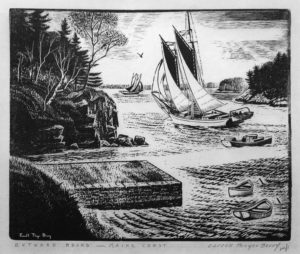
























Carroll Thayer Berry (1886–1978) Biography
Carroll Thayer Berry (1886-1978) is a printmaker known for his emblematic wood engravings of Maine. Berry was born and raised in New Gloucester, Maine, and cherished his home state, specifically the glory of her seacoast villages. He believed they were in danger of disappearing, and made it his life-long passion to capture them in his prints. Berry focused on indigenous subjects, including the limestone mills in Rockland, the windjammers of Rockport and Camden harbors, local fishermen and lobstermen, the falls in Camden, Deer Isle, and Port Clyde, among others.
As the son of a dairy farmer, Berry did not want to follow in his father’s footsteps. Instead, he enrolled at the University of Michigan and became an engineer. He returned to New England in 1909 as a mechanical draftsman for an engineering company in the Boston. Although Berry thought like an engineer, he dreamed like an artist, and began taking art classes at night in Boston.
In 1910, Berry travelled to Panama to participate in the construction of the Panama canal. He contracted malaria and was sent home where he returned to his art studies, this time at the Pennsylvania Academy of Fine Arts. Berry returned to Panama as an inspector of construction and after his artistic skills were noticed by government officials, Berry was commissioned to paint a series of large murals celebrating the opening of the Panama Canal in 1914.
In 1915, Berry returned to the US, and moved to New York City where he became a commercial. Soon after, he married, and he and his wife raised a son. In 1917, Berry enlisted during World War I and was assigned to the American Camouflage Corps, where alongside a number of other artists and designers, he created camouflage designs for soldiers in the field.
After World War I, Berry settled in Chicago and worked as a designer of installations and interiors for office buildings. Berry’s professional life took him to several American cities where he learned engraving, illustration, and much about the marine environment. He made murals, paintings, and drawings of the great ship-building industry of Maine centered around the Bath Iron Works.
During the Depression, many artists, like Berry, turned to printmaking to survive. Berry and his second wife, Janet Laura Scott, herself an artist, moved back to Maine and bought a house in Wiscasset. Berry wanted his prints to be available to as many people as possible and sold them for $5 in the 1950s. Eventually an artist confronted him on his prices, saying others artists couldn’t compete. Although Berry raised his prices, he never sold a print for more than $15. The collection of Berry prints at Courthouse Gallery comes from the artist’s estate, and are still accessible to everyone.
Carroll Thayer Berry’s emblematic wood engraving are his legacy to Maine art and the people of Maine.
Press
Ellsworth gallery showcases Carroll Thayer Berry’s woodcut prints of Maine coast
Everyone has seen those idyllic depictions of coastal Maine in paintings and photographs. Brilliantly colorful lighthouses, sturdy pine trees and perfectly timed waves spraying up against the rocks — the ideal thing to hang in a summer visitor’s dining room, back in their year-round home in New Jersey or Florida. And then there’s the work […]
Read More